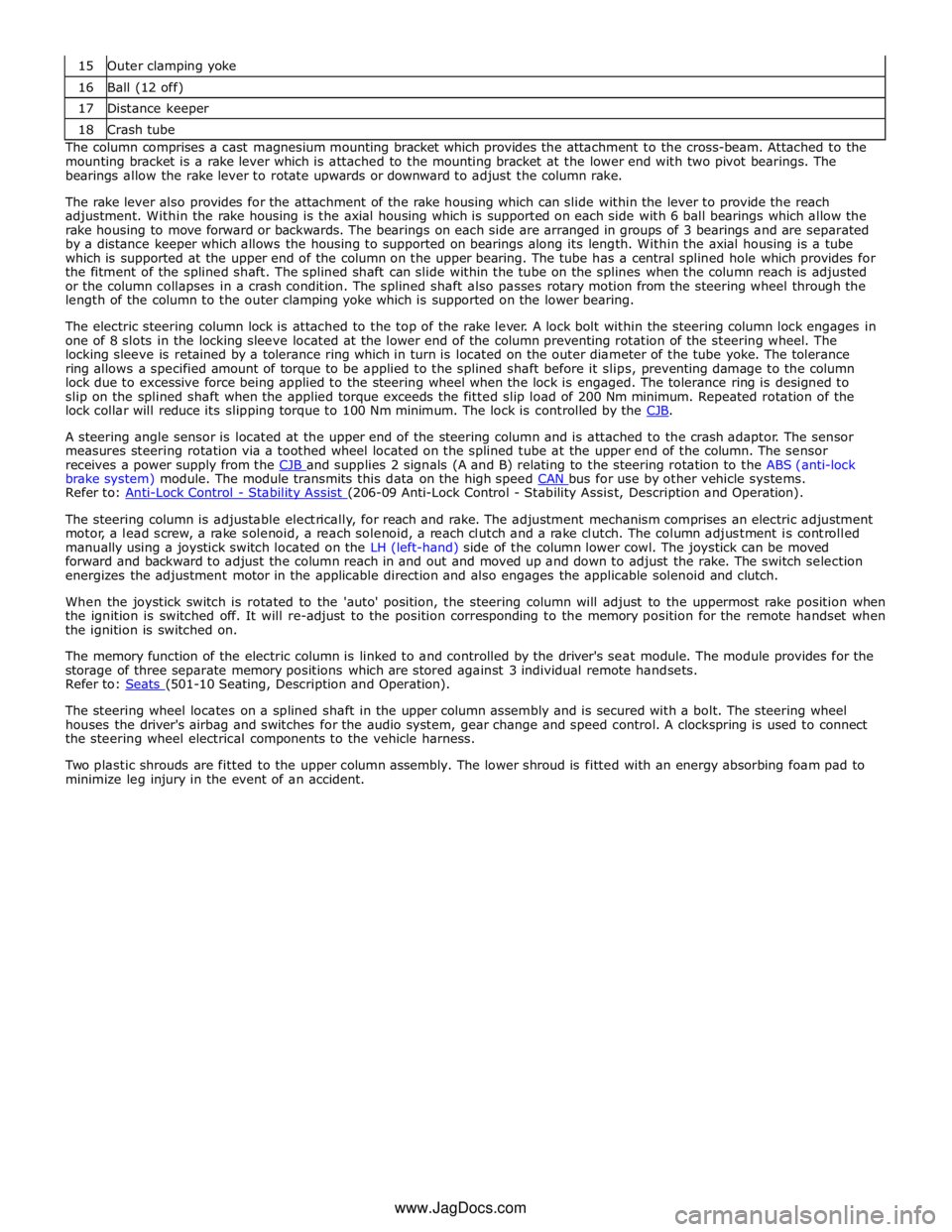2010 JAGUAR XFR seat memory
[x] Cancel search: seat memoryPage 27 of 3039

Memory Seat Position Switch
Seat Base
Rear Seat Backrest Cover (76.70.48) (78.90.12)
Rear Seat Cushion (76.70.37)
Front Seat Height Adjustment Motor
Front Seat Control Switch
Front Seat Head Restraint Motor (86.75.17)
Rear Seat Bolster
Front Seat Backrest Cover Trim Panel501-11: Glass, Frames and MechanismsSpecificationDescription and OperationComponent Location
Overview
System Operation and Component DescriptionDiagnosis and TestingGlass, Frames and Mechanisms
Fixed Window GlassGeneral ProceduresDoor Window Motor InitializationRemoval and InstallationDriver Door Window Control Switch (86.25.03) (86.25.08)
Front Door Window Glass
Front Door Window Regulator and Motor (76.31.45)
Rear Door Fixed Window Glass
Rear Door Window Glass
Rear Door Window Regulator and Motor
Rear Window Glass
Windshield Glass
Door Window Regulator Motor (86.25.04)501-12: Instrument Panel and ConsoleSpecificationDescription and OperationComponent Location
Overview
System Operation and Component DescriptionRemoval and InstallationFloor Console
Floor Console Cup Holder
Floor Console Double Cup Holder
Floor Console Side Trim Panel
Glove Compartment
Page 53 of 3039

Bus Topology of a
communication
network Coast Clutch Solenoid CCS Camshaft Position CMP Indicates camshaft position Carbon dioxide CO² Colorless gas with a density of approximately 1.5 times that of air Carbon monoxide CO Poisonous gas produced as the result of incomplete combustion Chlorofluorocarbon CFC Catalytic converter
In-line exhaust system device used to reduce the level of engine exhaust
emissions Celsius C
SI term for the Centigrade scale, with freezing point at zero and boiling point at 100 degrees Compact Disc CD Cylinder Head Temperature
Sensor CHT Sensor A sensor for measuring the temperature of the cylinder head Central Junction Box CJB Crankshaft Position CKP Indicates crankshaft position Clutch Pedal Position CPP Indicates clutch pedal position Controller Area Network CAN
A communication system which allows control modules to be linked together Constant Velocity CV Cubic centimeter cm³ Central Security Module CSM Electronic module to support security system functionality Data Link Connector DLC
Connector providing access and/or control of the vehicle information, operating conditions, and diagnostic information Driver Door Module DDM Electronic module to support driver door functionality Driver Seat Module DSM Electronic module to support driver seat functionality Daytime Running Lamps DRL Deutsche Institut fur Normung DIN German standards regulation body Diagnostic Trouble Code DTC
An alpha/numeric identifier for a fault condition identified by the On-Board Diagnostic (OBD) system Direct current dc
Current which flows in one direction only, though it may have appreciable pulsations in its magnitude Domestic Data Bus D2B Digital Versatile Disc DVD Electronic Automatic Temperature Control EATC
Exhaust Gas Recirculation EGR Exhaust Gas Recirculation Temperature Sensor EGRT Sensing EGR function based on temperature change Electronic Brake Force
Distribution EBD
Engine Control Module ECM Electronic module to support engine functionality Electronic Crash Sensor ECS Sensor to measure severity of impact Engine Coolant Temperature ECT Engine Oil Pressure EOP European On-Board Diagnostic EOBD Electronic Pressure Control EPC Electrically Erasable
Programmable Read-Only Memory EEPROM
Erasable Programmable
Read-Only Memory EPROM
Evaporative Emission EVAP
System designed to prevent fuel vapor from escaping into the atmosphere. Typically includes a charcoal filled canister to absorb fuel vapor Flash Electrically Erasable
Programmable Read-Only Memory FEEPROM
Front Electronic Module FEM Flash Erasable Programmable
Read-Only Memory FEPROM
Frequency Modulation FM Fuel Pump Driver Module FPDM Fuel Rail Pressure FRP Generic Electronic Module GEM Ground GND
Electrical conductor used as a common return for an electrical circuit or
circuits, and with a relative zero potential Global Positioning System GPS Global System for Mobile
Communication GSM
Gross Vehicle Weight GVW Heated Oxygen Sensor HO2S Electrically heated oxygen sensor which induces fuelling corrections
Page 55 of 3039

Programmable Read-only Memory PROM ROM with some provision for setting the stored data after manufacture Portable Support Electronics PSE Power Steering Pressure PSP Polytetrafluoroethylene PTFE Random Access Memory RAM
Fast access memory store which is accessible for entry or extraction of
data Read Only Memory ROM Fast access memory in which data is fixed and may not be changed Restraints Control Module RCM
Electronic module to support functionality of the Supplemental Restraints System Radio Data System RDS Rear Electronic Module REM Remote Keyless Entry RKE Right-hand RH Right-hand drive RHD Research Octane Number RON Rear Seat Module RSM Electronic module to support functionality of rear seats Supercharger SC
An intake system which utilizes a supercharger (mechanically driven
device that pressurizes intake air, thereby increasing density of charge air
and the consequent power output from a given displacement) Serial Communications Link SCL Standard Corporate Protocol SCP
A high-speed, serial communications system linking all body system
control modules. Control messages and data are passed between modules
at up to 786 messages per second Supplemental Restraints System SRS
Shift Solenoid SS Controls shifting in an automatic transmission Seat Control Module SCM
Module controlling the seat motor systems (not electric raise/lower-only seats) Secondary Air Injection AIR
System used for a period of time each time the engine is started, unless
certain temperature criteria are met. Pumps air directly into the exhaust
system which generates extra heat and reduces the time taken for the catalytic converters to reach operating temperature Service Repair Operation
(number) SRO
Number generated by Jaguar Methods & Techniques system which relates
to the time allowed to complete a repair operation. Further information on
the system can be found in the separate Jaguar Publications (for each
model range) entitled 'Repair Operation Times' Society of Automotive Engineers SAE
Timing/Coast Clutch Solenoid T/CCS Torque Converter Clutch TCC Transmission Control Indicator
Lamp TCIL
Throttle Position TP Top Dead Center TDC Transmission Control Module TCM Controls the shifting pattern of the (automatic) transmission Transmission Control Switch TCS Modifies the operation of electronically controlled transmissions Transmission Fluid Temperature TFT Indicates temperature of transmission fluid Transmission Range TR The range in which the transmission is operating Turbine Shaft Speed TSS Indicates rotational speed of transmission output shaft or turbine shaft Variable Assist Power Steering VAPS Variable Camshaft Timing VCT
A system by which the relationship of the crankshaft and camshaft may be
altered during engine running Vehicle Identification Number VIN
Number assigned to the vehicle by the manufacturer, primarily for licensing and identification purposes Vehicle Speed Sensor VSS Sensor which provides vehicle speed information Worldwide Diagnostic System WDS Jaguar approved diagnostic system Wide Open Throttle WOT Full throttle position www.JagDocs.com
Page 155 of 3039

DTC Description Possible Causes Action B1B92-15
Seat Recline Motor Relay -
Circuit short to battery or
open
Driver seat recline motor
circuit - short to power, open
circuit
Carry out any pinpoint tests associated
with this DTC using the manufacturer
approved diagnostic system. Refer to the
electrical circuit diagrams and check driver
seat recline motor circuit for short to
power, open circuit B1B93-31
Seat Recline Motor
Speed/Position Sensor - No
signal
Harness/connector problem
No signal from sensor
Sensor/motor malfunction
Check the seat wiring harness/connectors
for security/integrity
Refer to the electrical circuit diagrams and
check the seat recline motor speed sensor
circuit. Repair circuit as required. Clear DTC
and retest B1B94-24
Seat Height Up Switch -
Signal stuck high
Signal stuck high
Check for a stuck switch. Refer to the
electrical circuit diagrams and check driver
seat switch pack to seat module LIN circuit
for short, open circuit and seat height up
circuit for short to ground B1B95-24
Seat Height Down Switch -
Signal stuck high
Signal stuck high
Check for a stuck switch. Refer to the
electrical circuit diagrams and check driver
seat switch pack to seat module LIN circuit
for short, open circuit and seat height
down circuit for short to ground B1B96-24
Seat Slide Forward Switch -
Signal stuck high
Signal stuck high
Check for a stuck switch. Refer to the
electrical circuit diagrams and check driver
seat switch pack to seat module LIN circuit
for short, open circuit and seat slide
forward circuit for short to ground B1B97-24 Seat Slide Backward Switch
- Signal stuck high
Signal stuck high
Check for a stuck switch. Refer to the
electrical circuit diagrams and check driver
seat switch pack to seat module LIN circuit
for short, open circuit and seat slide
backward circuit for short to ground B1B98-24
Seat Tilt Up Switch - Signal
stuck high
Signal stuck high
Check for a stuck switch. Refer to the
electrical circuit diagrams and check driver
seat switch pack to seat module LIN circuit
for short, open circuit and seat tilt up
circuit for short to ground B1B99-24
Seat Tilt Down Switch -
Signal stuck high
Signal stuck high
Check for a stuck switch. Refer to the
electrical circuit diagrams and check driver
seat switch pack to seat module LIN circuit
for short, open circuit and seat tilt down
circuit for short to ground B1C00-24
Seat Recline Up Switch -
Signal stuck high
Signal stuck high
Check for a stuck switch. Refer to the
electrical circuit diagrams and check driver
seat switch pack to seat module LIN circuit
for short, open circuit and seat recline up
circuit for short to ground B1C01-24
Seat Recline Down Switch -
Signal stuck high
Signal stuck high
Check for a stuck switch. Refer to the
electrical circuit diagrams and check driver
seat switch pack to seat module LIN circuit
for short, open circuit and check seat
recline down circuit for short to ground B1C02-24
Memory Store Switch -
Signal stuck high
Signal stuck high
Check for a stuck switch. Refer to the
electrical circuit diagrams and check driver
seat switch pack to seat module LIN circuit
for short, open circuit www.JagDocs.com
Page 156 of 3039

DTC Description Possible Causes Action B1C03-24
Memory #1 Switch - Signal
stuck high
Signal stuck high
Check for a stuck switch. Refer to the
electrical circuit diagrams and check driver
seat switch pack to seat module LIN circuit
for short, open circuit B1C04-24
Memory #2 Switch - Signal
stuck high
Signal stuck high
Check for a stuck switch. Refer to the
electrical circuit diagrams and check driver
seat switch pack to seat module LIN circuit
for short, open circuit B1C05-24
Memory #3 Switch - Signal
stuck high
Signal stuck high
Check for a stuck switch. Refer to the
electrical circuit diagrams and check driver
seat switch pack to seat module LIN circuit
for short, open circuit U0010-88
Medium speed Can
communication Bus - Bus
off
Bus off
Carry out any pinpoint tests associated
with this DTC using the manufacturer
approved diagnostic system. Refer to the
electrical circuit diagrams and check CAN
network to climate controlled seat module
for short, open circuit U0140-00
Lost communication with
CJB - No sub type
information
Lost communication with CJB
Carry out any pinpoint tests associated
with this DTC using the manufacturer
approved diagnostic system. Check CJB for
related DTCs and refer to the relevant DTC
Index U0142-00
Lost communication with
RJB - No sub type
information
Lost communication with RJB
Carry out any pinpoint tests associated
with this DTC using the manufacturer
approved diagnostic system. Check RJB for
related DTCs and refer to the relevant DTC
Index U0155-00
Lost communications with
instrument cluster - No sub
type information
Lost communications with
instrument cluster
Carry out any pinpoint tests associated
with this DTC using the manufacturer
approved diagnostic system. Refer to the
electrical circuit diagrams and check CAN
network to climate controlled seat module
and instrument cluster for short, open
circuit U0199-00
Lost communication with
Driver Door Module (DDM) -
No sub type information
Lost communication with DDM
Carry out any pinpoint tests associated
with this DTC using the manufacturer
approved diagnostic system U0300-00
Internal control module
software incompatibility -
No sub type information
Invalid configuration message
is received
Re-configure the RJB using the
manufacturer approved diagnostic system.
Clear the DTC and retest. If the DTC is still
logged suspect the DSM/PSM, refer to the
new module installation note at the top of
the DTC Index U1A14-49
CAN Initialisation failure -
Internal electronic failure
Internal electronic failure
Install a new DSM, refer to the new
module installation note at the top of the
DTC Index U1A4C-68
Build/end of line mode
active - Event information
Manufacturing mode has not
been removed
Place DSM in to customer mode using
manufacturer approved diagnostic system U3000-49
Control module - Internal
electronic failure
Internal electronic failure
Install a new DSM, refer to the new
module installation note at the top of the
DTC Index
Page 777 of 3039

Steering Column - Steering Column - Overview
Description and Operation
OVERVIEW Published: 11-May-2011
The steering column comprises the upper column assembly, the lower column assembly and the steering wheel. The 3
components are positively connected together to pass driver rotary input from the steering wheel to a linear output of the
steering rack.
The upper column assembly contains electrical adjustment for steering wheel reach and rake, the electric steering lock
mechanism and the steering angle sensor. Steering adjustment memory positions are stored in the driver's seat module.
The electric steering column is a standard fitment on all models. The upper column assembly contains electrical adjustment for
steering wheel reach and rake, the electric column lock mechanism and the steering angle sensor. Steering adjustment memory
positions are stored in the driver's seat module. The column also features a 'tilt away' function which moves the steering
column away from the driver allowing easier exit and entry to the vehicle.
Column adjustment is provided by a single motor for both reach and rake adjustment. Operation of the column adjustment is
controlled by a four way joystick type switch located in the column lower shroud. Column adjustment is an integral part of the
driver position memory system.
www.JagDocs.com
Page 779 of 3039

8 Reach adjustment solenoid and potentiometer 9 Column adjustment motor 10 Instrument cluster 11 Steering column adjust switch 12 Driver's seat module (position memory)
STEERING COLUMN ADJUSTMENT System Operation
Power for the column adjustment motor is supplied via a megafuse in the BJB to the CJB. A fused supply from the CJB is passed to the instrument cluster which controls the power application to the motor.
The column adjust switch is hardwired to the instrument cluster. Up/down and in/out selections on the switch are each passed
through a resistor of differing values to the instrument cluster. The cluster monitors the output value from the switch and
operates the motor in the required direction and simultaneously energizes the required solenoid for rake or reach adjustment.
When the applicable solenoid is energized, a clutch is engaged and locates on a lead screw. The motor rotates the lead screw
and the rotational drive of the screw is transferred into linear movement of the applicable clutch to move either the rake or
reach adjustment. For reach adjustment, the lead screw drives the outer housing in or out as required. For rake adjustment the
lead screw drives a rake lever which moves the column up or down as required.
The position of the column is monitored by potentiometers which are connected to the instrument cluster. The cluster monitors
the output signal from the potentiometers to precisely control the positioning of the column in each plane.
The instrument cluster controls the memory positioning of the column via a medium speed CAN bus connection to the driver's seat module. The driver's seat module receives information regarding the particular remote handset used to enter the vehicle
and outputs positional information relative to that stored for the handset. This information is passed to the instrument cluster
via the medium speed CAN bus which moves the column to the memorized positions.
The column logic in the instrument cluster also incorporates an entry/exit mode. When the vehicle is unlocked or the ignition is
switched off, the instrument cluster lifts the column upwards to its maximum rake position to allow the driver more room below
the steering wheel and improve access/egress of the vehicle. When the ignition is next switched on the column will adjust to
its previous position.
The electric steering column lock is controlled by the CJB.
Page 782 of 3039

16 Ball (12 off) 17 Distance keeper 18 Crash tube The column comprises a cast magnesium mounting bracket which provides the attachment to the cross-beam. Attached to the
mounting bracket is a rake lever which is attached to the mounting bracket at the lower end with two pivot bearings. The
bearings allow the rake lever to rotate upwards or downward to adjust the column rake.
The rake lever also provides for the attachment of the rake housing which can slide within the lever to provide the reach
adjustment. Within the rake housing is the axial housing which is supported on each side with 6 ball bearings which allow the
rake housing to move forward or backwards. The bearings on each side are arranged in groups of 3 bearings and are separated
by a distance keeper which allows the housing to supported on bearings along its length. Within the axial housing is a tube
which is supported at the upper end of the column on the upper bearing. The tube has a central splined hole which provides for
the fitment of the splined shaft. The splined shaft can slide within the tube on the splines when the column reach is adjusted
or the column collapses in a crash condition. The splined shaft also passes rotary motion from the steering wheel through the
length of the column to the outer clamping yoke which is supported on the lower bearing.
The electric steering column lock is attached to the top of the rake lever. A lock bolt within the steering column lock engages in
one of 8 slots in the locking sleeve located at the lower end of the column preventing rotation of the steering wheel. The
locking sleeve is retained by a tolerance ring which in turn is located on the outer diameter of the tube yoke. The tolerance
ring allows a specified amount of torque to be applied to the splined shaft before it slips, preventing damage to the column
lock due to excessive force being applied to the steering wheel when the lock is engaged. The tolerance ring is designed to
slip on the splined shaft when the applied torque exceeds the fitted slip load of 200 Nm minimum. Repeated rotation of the
lock collar will reduce its slipping torque to 100 Nm minimum. The lock is controlled by the CJB.
A steering angle sensor is located at the upper end of the steering column and is attached to the crash adaptor. The sensor
measures steering rotation via a toothed wheel located on the splined tube at the upper end of the column. The sensor
receives a power supply from the CJB and supplies 2 signals (A and B) relating to the steering rotation to the ABS (anti-lock brake system) module. The module transmits this data on the high speed CAN bus for use by other vehicle systems. Refer to: Anti-Lock Control - Stability Assist (206-09 Anti-Lock Control - Stability Assist, Description and Operation).
The steering column is adjustable electrically, for reach and rake. The adjustment mechanism comprises an electric adjustment
motor, a lead screw, a rake solenoid, a reach solenoid, a reach clutch and a rake clutch. The column adjustment is controlled
manually using a joystick switch located on the LH (left-hand) side of the column lower cowl. The joystick can be moved
forward and backward to adjust the column reach in and out and moved up and down to adjust the rake. The switch selection
energizes the adjustment motor in the applicable direction and also engages the applicable solenoid and clutch.
When the joystick switch is rotated to the 'auto' position, the steering column will adjust to the uppermost rake position when
the ignition is switched off. It will re-adjust to the position corresponding to the memory position for the remote handset when
the ignition is switched on.
The memory function of the electric column is linked to and controlled by the driver's seat module. The module provides for the
storage of three separate memory positions which are stored against 3 individual remote handsets.
Refer to: Seats (501-10 Seating, Description and Operation).
The steering wheel locates on a splined shaft in the upper column assembly and is secured with a bolt. The steering wheel
houses the driver's airbag and switches for the audio system, gear change and speed control. A clockspring is used to connect
the steering wheel electrical components to the vehicle harness.
Two plastic shrouds are fitted to the upper column assembly. The lower shroud is fitted with an energy absorbing foam pad to
minimize leg injury in the event of an accident.
www.JagDocs.com